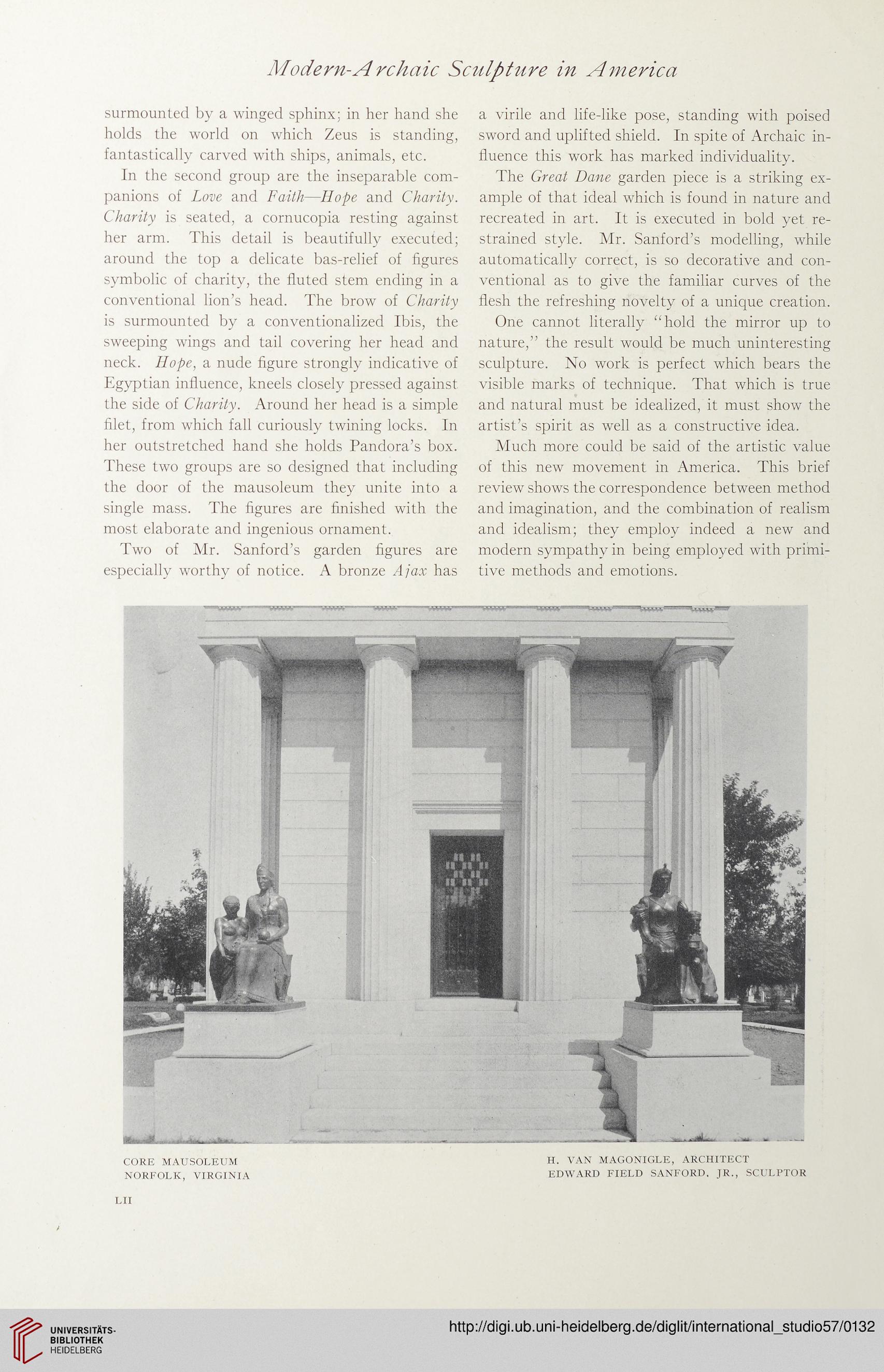Modern-Archaic Sculpture in America
surmounted by a winged sphinx: in her hand she
holds the world on which Zeus is standing,
fantastically carved with ships, animals, etc.
In the second group are the inseparable com-
panions of Love and Faith—Hope and Charity.
Charity is seated, a cornucopia resting against
her arm. This detail is beautifully executed;
around the top a delicate bas-relief of figures
symbolic of charity, the fluted stem ending in a
conventional lion’s head. The brow of Charity
is surmounted by a conventionalized Ibis, the
sweeping wings and tail covering her head and
neck. Hope, a nude figure strongly indicative of
Egyptian influence, kneels closely pressed against
the side of Charity. Around her head is a simple
filet, from which fall curiously twining locks. In
her outstretched hand she holds Pandora’s box.
These two groups are so designed that including
the door of the mausoleum they unite into a
single mass. The figures are finished with the
most elaborate and ingenious ornament.
Two of Mr. Sanford’s garden figures are
especially worthy of notice. A bronze Ajax has
a virile and life-like pose, standing with poised
sword and uplifted shield. In spite of Archaic in-
fluence this work has marked individuality.
The Great Dane garden piece is a striking ex-
ample of that ideal which is found in nature and
recreated in art. It is executed in bold yet re-
strained style. Mr. Sanford’s modelling, while
automatically correct, is so decorative and con-
ventional as to give the familiar curves of the
flesh the refreshing novelty of a unique creation.
One cannot literally “hold the mirror up to
nature,” the result would be much uninteresting
sculpture. No work is perfect which bears the
visible marks of technique. That which is true
and natural must be idealized, it must show the
artist’s spirit as well as a constructive idea.
Much more could be said of the artistic value
of this new movement in America. This brief
review shows the correspondence between method
and imagination, and the combination of realism
and idealism; they employ indeed a new and
modern sympathy in being employed with primi-
tive methods and emotions.
CORE MAUSOLEUM
NORFOLK, VIRGINIA
H. VAN MAGONIGLE, ARCHITECT
EDWARD FIELD SANFORD. JR., SCULPTOR
LII
surmounted by a winged sphinx: in her hand she
holds the world on which Zeus is standing,
fantastically carved with ships, animals, etc.
In the second group are the inseparable com-
panions of Love and Faith—Hope and Charity.
Charity is seated, a cornucopia resting against
her arm. This detail is beautifully executed;
around the top a delicate bas-relief of figures
symbolic of charity, the fluted stem ending in a
conventional lion’s head. The brow of Charity
is surmounted by a conventionalized Ibis, the
sweeping wings and tail covering her head and
neck. Hope, a nude figure strongly indicative of
Egyptian influence, kneels closely pressed against
the side of Charity. Around her head is a simple
filet, from which fall curiously twining locks. In
her outstretched hand she holds Pandora’s box.
These two groups are so designed that including
the door of the mausoleum they unite into a
single mass. The figures are finished with the
most elaborate and ingenious ornament.
Two of Mr. Sanford’s garden figures are
especially worthy of notice. A bronze Ajax has
a virile and life-like pose, standing with poised
sword and uplifted shield. In spite of Archaic in-
fluence this work has marked individuality.
The Great Dane garden piece is a striking ex-
ample of that ideal which is found in nature and
recreated in art. It is executed in bold yet re-
strained style. Mr. Sanford’s modelling, while
automatically correct, is so decorative and con-
ventional as to give the familiar curves of the
flesh the refreshing novelty of a unique creation.
One cannot literally “hold the mirror up to
nature,” the result would be much uninteresting
sculpture. No work is perfect which bears the
visible marks of technique. That which is true
and natural must be idealized, it must show the
artist’s spirit as well as a constructive idea.
Much more could be said of the artistic value
of this new movement in America. This brief
review shows the correspondence between method
and imagination, and the combination of realism
and idealism; they employ indeed a new and
modern sympathy in being employed with primi-
tive methods and emotions.
CORE MAUSOLEUM
NORFOLK, VIRGINIA
H. VAN MAGONIGLE, ARCHITECT
EDWARD FIELD SANFORD. JR., SCULPTOR
LII




